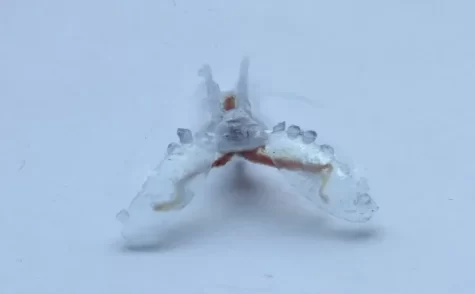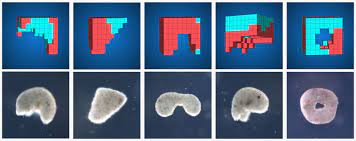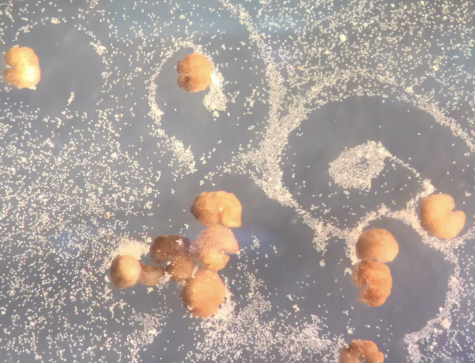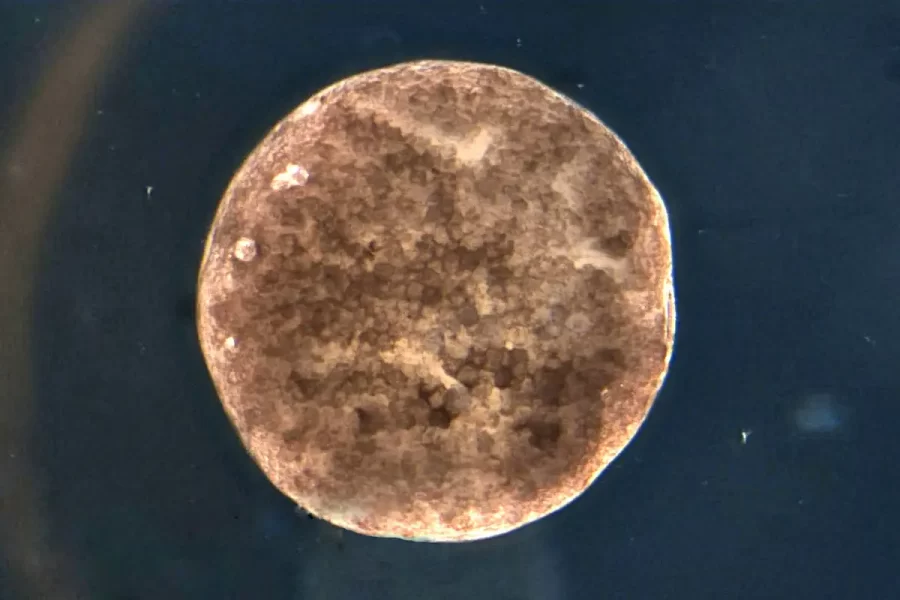Xenobots: Aliens on Earth
February 24, 2023
In 2020, scientists created a new form of life. Known as Xenobots, scientists separated stem cells from the embryos of the frog Xenpous laevis, configuring them into new shapes based on AI-generated designs. In doing so, the stem cells that would have become the skin of tadpoles became distinct organisms, as seen above.
These microscopic organisms were hand built by scientists, thus being known as “biobots.” Normally, biobots are created when scientists combine biological material with non-biological material to produce robots with the abilities of biological creatures. This has mostly been seen using small clumps of muscle cells to create biobots that could move in a way that better resembled natural organisms, such as the biobot seen below, created using sea slug muscles that are manipulated using controlled electric signals. Yet, the Xenobots were the first biobots created using entirely biological material. Using stem cells, compared to just muscle cells, means that the Xenobots are alive, not just cells that have to be remotely manipulated.
 A biobot created using sea slug muscles.
A biobot created using sea slug muscles.
So, they’re distinct organisms, but what makes them so special? First off, as mentioned before, the shape of these organisms was designed by AI. A supercomputer cluster at the University of Vermont ran an AI program that designed millions of tests with “biobots” in a virtual environment using cubes. As seen below, these cubes represented stem cells. The red cells would move, while blue cells would stay stagnant. In trying out millions of various shapes, each of those below allowed the Xenobots to move entirely differently. Furthermore, were discovered to be able to heal within minutes when injured, showing that they could truly respond to environmental stimulation. Yet, the astonishing part of these new life forms wasn’t seen until a different design was created and tested out.

Xenobot designs created by AI compared to their stem cell results.
These Xenobots, after many tests, were introduced to obstacles in their environment. When this happened, they began to spin, collecting the debris into piles in their petri dish. This was unexpected. When nutrients were added to the debris, the Xenobots would sort through until they found it. This was even more unexpected, as it showed that creatures without any intelligence beyond the cellular need for nutrients could still act with their survival in mind. This action of collecting was then taken further when the AI was used to create a Xenobot design that resembled Pac-Man, a sphere with one large “mouth” opening, as seen below. The Xenobots became very effective in this activity, which opened the door for many new possible uses of such microscopic biobots, such as clearing blocked blood vessels or possibly even collecting cancerous cells.

New Xenobot design in a debris-filled petri dish.
Yet, this activity has been seen in other AI-generated creations, but further environmental additions made the truly “alien” thing arise from this activity. As scientists continued testing the Xenobots, they tried out adding more Xenopous laevis stem cells to the biobot’s environment. In reaction, the Xenobots separated these stem cells from the debris, forming them into separate clumps. After some time these clumps of stem cells formed new Xenobots, perfectly resembling their “parents.” This was groundbreaking, as such replication, known now as “kinematic replication,” is new to Earth.
Previously, the Xenobots would die after some time, but now they began to create generation after generation of exact replicas of the scientist-built initial generation. This opened hundreds of new doorways in science. Not only does this show a new form of life truly exists, but this proof also shows that microscopic life on other planets may be different than we expected, changing what we might have to look for. It also shows that there might be an even wider range of medical uses for Xenobots now that they can reproduce, surviving much longer than before. Yet, this also causes many questions, which may be answered as scientists continue to study Xenobots.
From spinning clumps of cells to a new form of life and biological replication, Xenobots are a breakthrough in science, one that was overlooked with the rise of the Covid-19 pandemic. In the end, the discoveries made through studying Xenobots, and the interaction of AI and biological design, continue to arise and may shape the future of medical use of robotics.





